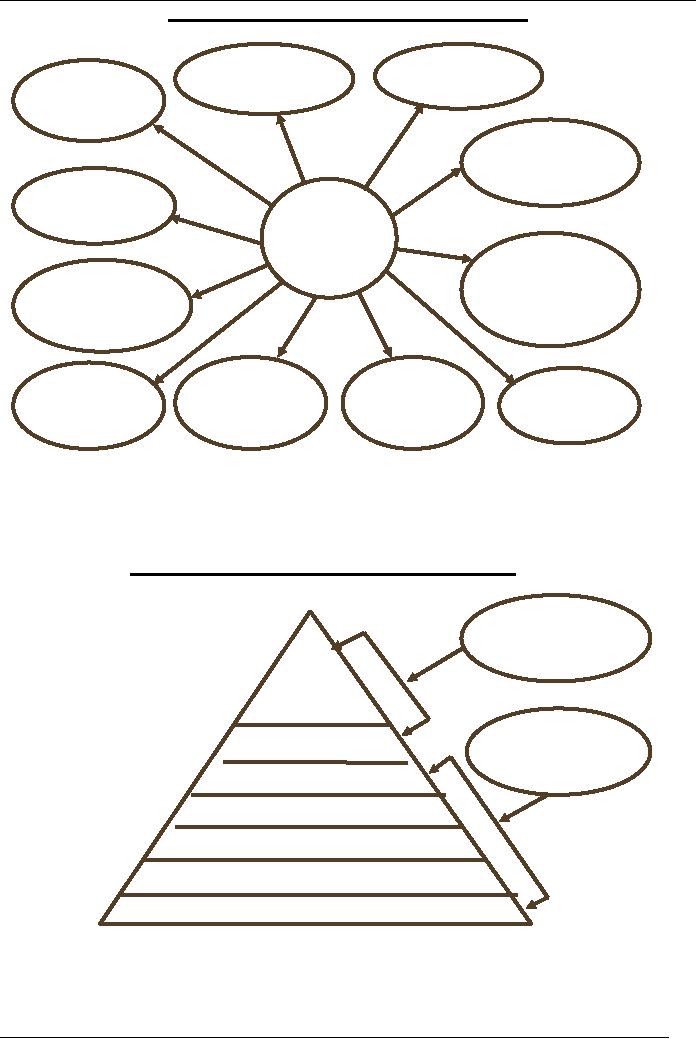 |

Advertising
and Promotion (MKT621)
VU
Lesson
8
ADVERTISING
PLANNING
LECTURE
OVERVIEW
In
this lecture information will be
provided about advertising
planning specially the
consumer
behavior,
types of advertising .The
communication objectives will also be
explained besides the
positioning
as required by the client
for its product etc, and
related strategies.
ADVERTISING
PLANNING (CONSUMER
BEHAVIOUR)
·
What
motivates the buyer?
·
Why
does buyer choose a specific
brand over others?
·
Why
does buyer buys from
where he or she buys?
·
What
makes buyer shift from one
brand to another & from one shop to
another?
·
What
are buyer's reactions to
newly introduced
product?
·
What
are the various stages
buyer passes through before
making a decision?
ADVERTISING
OBJECTIVES
An
advertisement, to be effective, should
be
Seen--ReadUnderstood
Believed & Acted
upon
So
there are three
objectives:-
·
Sales
Objectives. Immediate increase in
sales percentage(Chart No 1)
·
Communications
Objectives. Increase in market
share (Chart No 2)
·
Behavior
related Objectives. Increasing
company's brand usage rate
among existing
consumers
and Encouraging non-users to have
trial consumption and / or
purchase
Types
of Advertising
·
Brand
Advertising.
·
Retail
or Local Advertising.
·
Political
Advertising.
·
Directory
Advertising.
·
Direct
Response Advertising
·
Business
to Business Advertising.
·
Institutional
Advertising.
·
Public
Service Advertising.
·
Interactive
Advertising.
Target
Audience
How
to determine?
·
To
whom is advertising
addressed?
·
Where
will the objectives be achieved?
Process
of Identifying Target Audience
·
Identify
the market.
·
Identify
appropriate segments.
·
Decide
criteria for selecting
relevant segment.
·
Target
audience. (selected segments)
16

Advertising
and Promotion (MKT621)
VU
SALES
OBJECTIVES PROCESS Chart No.
1
Competitor
Economic
actions
Condition
Packaging
Brand
Image
Price
SALES
Consumer
Taste
Dist.
Channel
Preferences
Management
Product
Other
Sales
force
Quality
Promotional
Advertising
No
& Quality
Features
Mix
COMMUNICATIONS
OBJECTIVES Chart No 2
Behavioral
objectives
5%
Purchase
Reg.
buy
10%Trial
Communication
objectives
15%
Preference
20%
Liking
30%
knowledge
70%Generating
Awareness
100
% Unawareness
Communication
Response Pyramid
17

Advertising
and Promotion (MKT621)
VU
POSITIONING
·
Positioning
is the foundation upon which
all other marketing mix
decisions are built.
·
Positioning
involves a decision to emphasize or
highlight certain aspects of a
brand
So
Positioning
is not what you do to the product,
but is what you do to the minds of
the
consumers
through marketing communications.
Why
Positioning
"It
is the act of designing the
company's offering and image to occupy a
distinctive place in
the
target market's mind." .....
Philip
Kotler
Positioning
Strategies
Following
questions need
answers:
·
Who
am I : (Brand identity &
Image)
·
What
am I: (Functional capabilities of the
product)
·
For
whom am I: (Consumer segment I serve
best)
·
Why
me: (Powerful reason to
choose me)
Seven
Approaches to Positioning
Strategy
·
Using
product characteristics or customer
benefit approach.
·
The
price quality approach.
·
The
use or application approach.
·
The
product user approach.
·
The
product class approach.
·
The
cultural symbol approach.
·
The
competitor approach.
18
Table of Contents:
- INTRODUCTION TO ADVERTISING:Its growing importance, Explanation of Personal and non-personal selling
- INTRODUCTION TO ADVERTISING:ADVANTAGES, Communication, Information, Various Media
- INTRODUCTION TO ADVERTISING:FUNCTIONS OF ADVERTISING, IMPACT OF ADVERTISING
- ADVERTISING AND SOCIETY:PRACTICAL BENEFITS, ETHICS IN ADVERTISING, Marketplace & Market space
- MARKETING TOOLS:COMPONENTS OF MARKETING MIX, PRODUCT LIFE CYCLE (PLC) CURVE
- MARKETING TOOLS:SWOT Analysis, Contents & Structure, ROLE & FUNCTION OF ADVERTISING
- ROLE AND FUNCTIONS OF ADVERTISING:Structure of an Advertising Agency, How to Select an Advertising Agency
- ADVERTISING PLANNING:ADVERTISING OBJECTIVES, Types of Advertising, Positioning Strategies
- POSITIONING:BRANDING, 7 Steps of Creative Process, UNIVERSAL ADVERTISING STANDARDS
- ADVERTISING MESSAGE:Message Content, BASIC TERMS & CONCEPTS
- ADVERTISING BUDGET:4 Methods to determine, ADVERTISING RESEARCH, ADVERTISING RESEARCH
- ADVERTISING REACH:BROAD COMMUNICATION OBJECTIVES, ADVERTISING COPY METHODS, MEDIA RESEARCH
- PRE – PLACEMENT EVALUATION:ACCOUNT PLANNING, MARKET, COMPETITION
- WORKING OF ADVERTISING:12 Steps to develop effective campaign, SOURCE or THE ADVERTISER
- ADVERTISING RESPONSE HIERARCHY MODELS:AIDA MODEL, PROCESS REQUIRED TO GET BIG IDEA
- PROBLEM SOLVING STRATEGIES:Procedure to Handle Problems, In brief, Eight principles apply to consumer behavior
- CONSUMER BEHAVIOUR:ADVERTISING APEALS, MEDIA MIX DECISIONS, Target Rating Point (TRP)
- CREATIVITY IN ADVERTISING:Three aspects are most accepted, Four Rules of Creativity
- COPY WRITER:CHARACTERISTICS OF COPYWRITER, IMPORTANCE OF LANGUAGE
- WHY ADVERTISING:Advertising & Market Education, ADVERTISEMENT CAMPAIGNS
- METHODS TO APPRECIATE A PROBLEM:SPONSORSHIP—an important tool, Special Characteristics
- IMPORTANT TOOL OF ADVERTISING:TELEVISION ADVERTISING, TRANSIT ADVERTISING
- ONLINE ADVERTISING:Banners, Logos, Email Ads, Keywords on Search Engines, New Developments
- ONLINE ADVERTISING:Structural Challenges, Adobe Photoshop, JAVA, HTML, DHTML, ASP & JSP
- SALES PROMOTION:Consumer Oriented Promotion, HOW TO USE TRADE PROMOTION, Dealing with the Trade
- PUBLICITY:PERSONAL SELLING, ROLE OF SALES PERSON, FUTURE OF GLOBAL ADVERTISING
- MARKETING ENVIRONMENT:Competitors, The Target Buyer, Segmenting your Market, FUTURE OF MARKET GROWTH
- MARKETING PLAN:Situational Analysis, Macro – Environment Situation, Marketing Objectives, Financial Objectives
- MARKETING PLAN:PROMOTING BUSINESS IN LOW COST, SUPPLY CHAIN, BUYER IDENTIFICATION
- HOW TO BE GOOD CLIENTS:CHANNEL BUYERS, HOW TO BE GOOD CLIENTS 14 RULES
- CLIENT – AGENCY RELATIONSHIP:HOW TO KEEP CLIENTS (10 Ways), Three Points for Consideration
- CLIENT – AGENCY RELATIONSHIP:ADVERTISING WITHOUT AN AGENCY, LOGO AND CORPORATE IDENTITY
- NEWSPAPER ADVERTISING:AD PRODUCTION,TYPES OF NEWSPAPER ADS, CIRCULATION
- OTHER ADVERTISING MEDIUM:HOW TO USE MAGAZINES, HOW TO USE RADIO, Daypart buying options
- UTILITY OF VARIOUS MEDIA:TAPE OR FILM, UTILITY OF TV, DIRECT MAIL PACKAGE
- OTHER ADVERTISING MEDIA:POINT OF PURCHASE (POP), TRANSIT ADVERTISING, LIMITS OF ADVERTISING
- CONTINUOUS TRACKING:PLANNING CAMPAIGN, HOW TO UNDERSTAND ADS, ASK BASIC QUESTIONS
- SEASONAL ADVERTISING:MAXIMIZING IMPACT, THE WEB ADVERTISING, MEASURING ADVERTISING
- COMPONENTS OF ADVERTISING:BUY - OLOGY OF MIND, BUY - OLOGY OF MIND
- CRITICISM ON ADVERTISING:SHOULD ADVERTISING BE ABOLISHED,
- EFFECT OF ADVERTISING:HOW TO PROMPT AWARENESS, CREATING DESIGN THAT SELLS
- CREATING EFFECTIVE DESIGN:LANGUAGE OF TYPOGRAPHY, HEADLINES THAT COMMUNICATE
- WORKSHEETS:DEMOGRAPHICS OF YOUR TARGET, YOUR COMPETITOR
- GLOSSARY OF ADVERTISING:ACCOUNT EXECUTIVE, PROOF, VOICE OVER
- CONCEPT OF AN AD:HOW TO DEVELOP A CONCEPT OF AN AD